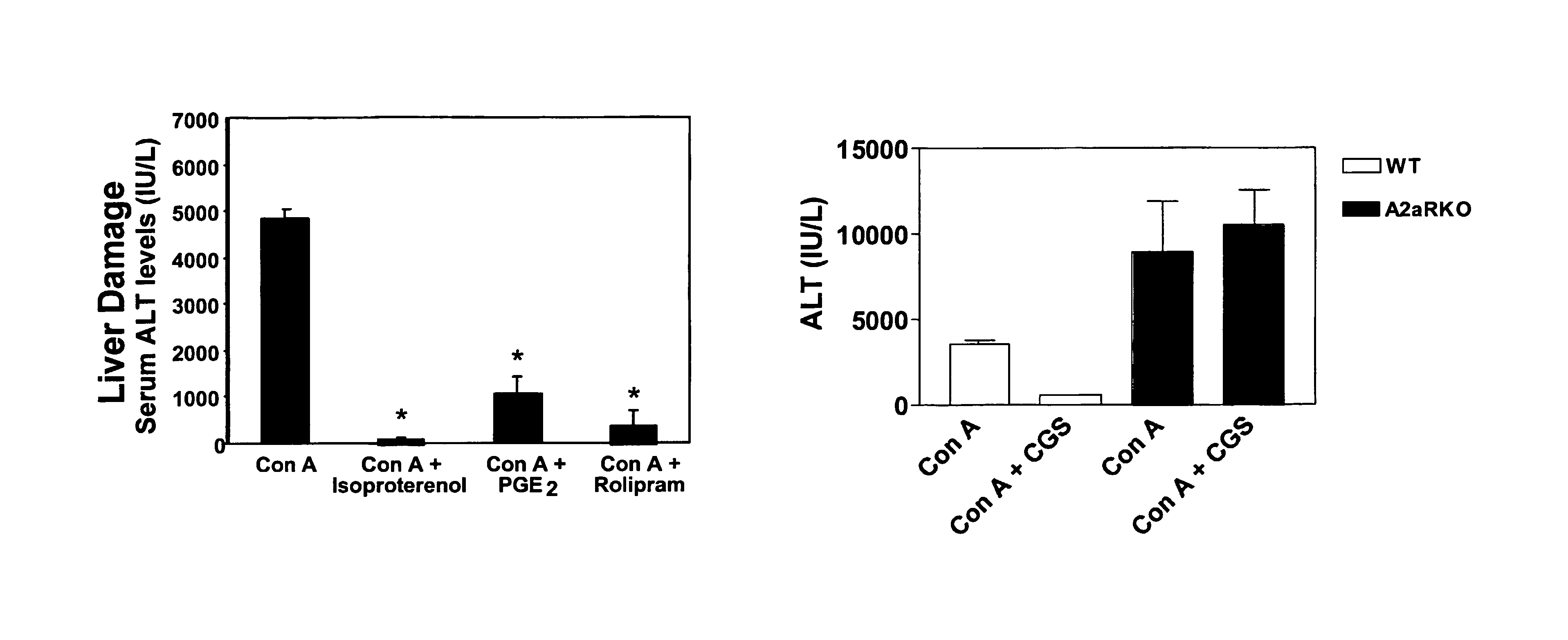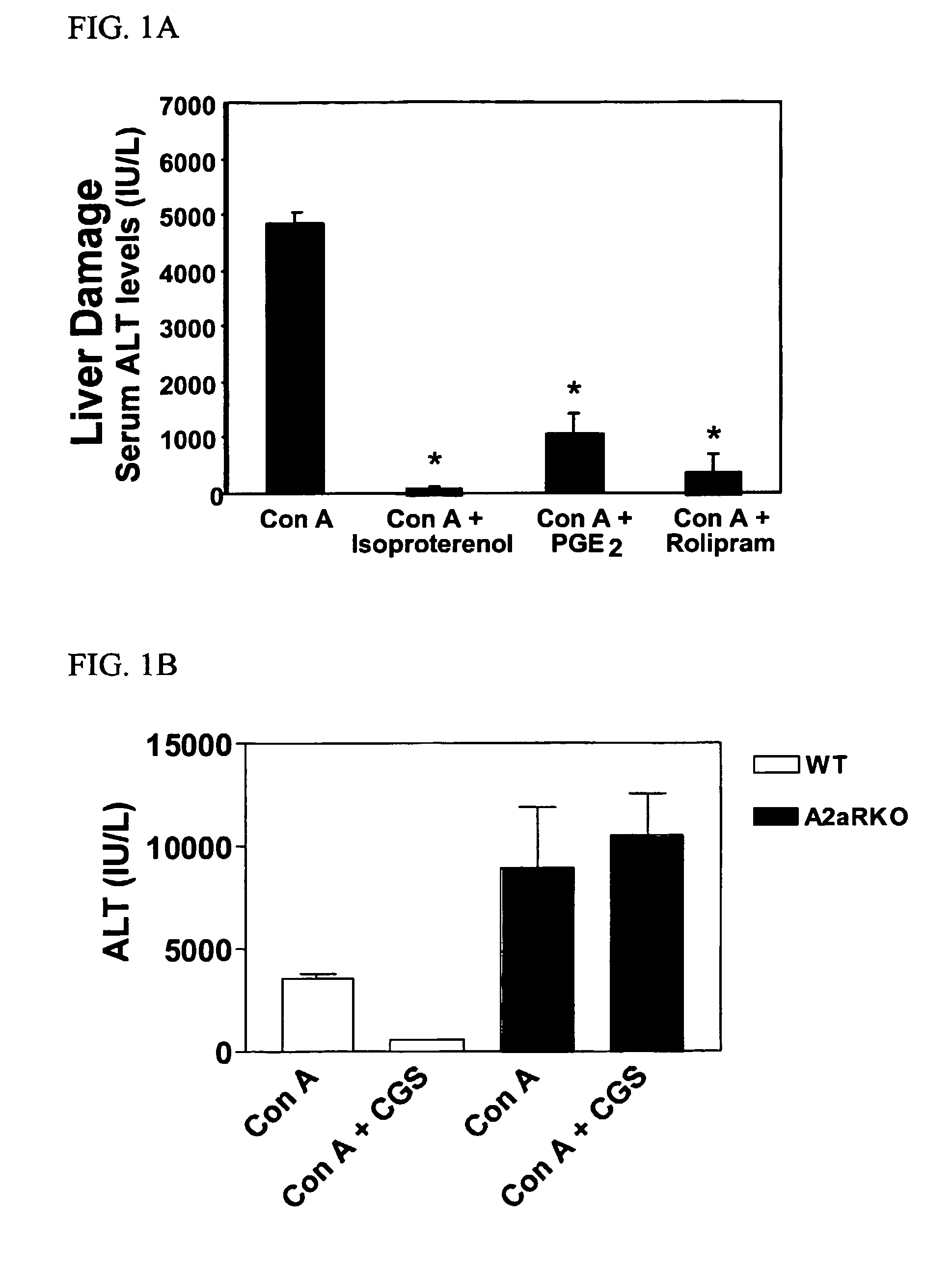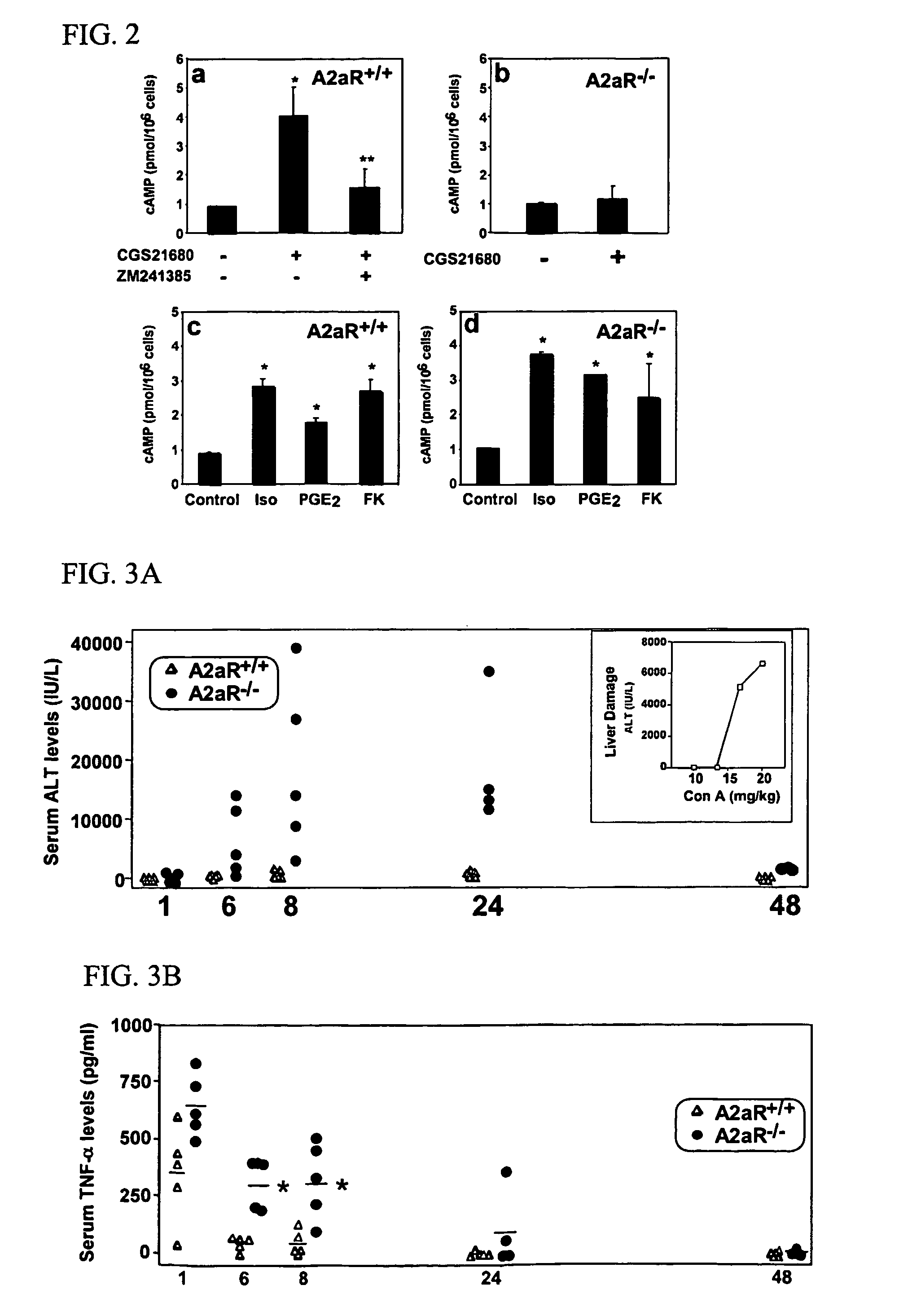Methods for using extracellular adenosine inhibitors and adenosine receptor inhibitors to enhance immune response and inflammation
a technology of adenosine receptor and adenosine inhibitor, which is applied in the direction of drug composition, immunological disorders, biological material analysis, etc., can solve the problems of increasing desirable and targeted tissue damage, and achieve the effects of limiting the immune response, prolonging the immune response, and increasing the immune respons
- Summary
- Abstract
- Description
- Claims
- Application Information
AI Technical Summary
Benefits of technology
Problems solved by technology
Method used
Image
Examples
example 1
Activation of A2a Receptors Reduces Concanavalin-A-Induced Liver Damage in vivo
[0202]This example describes methods that were used to demonstrate that pharmacological activation of A2a receptors by a selective A2a agonist prevents liver damage in a model of inflammatory liver injury.
[0203]Concanavalin A (Con-A)-induced liver injury in mice is mediated by T-cells, macrophages and pro-inflammatory cytokines TNF-α, IL4 and IFN-γ, and represents a well-described in vivo inflammation model of viral and autoimmune hepatitis. Five B6 wild type mice were injected intravenously (i.v.) with 20 mg / kg Con A (type IV, Sigma, St. Louis, Mo.) in sterile PBS alone or co-injected intraperitoneally (i.p.) with CGS21680 (2 mg / kg), isoproterenol (100 mg / kg, Sigma, St. Louis, Mo.), or prostaglandin E2 (PGE2, 5 mg / kg, Sigma, St. Louis, Mo.) just before Con A treatment. The extent of liver damage and inflammation were quantified by measuring serum levels of liver enzyme alanine aminotransferase (ALT) and ...
example 2
Effect of A2a Agonists and Antagonists on cAMP levels in Mouse Liver Mononuclear Cells in vitro
[0205]This example describes methods that were used to demonstrate that A2a receptor signaling (cAMP accumulation) is decreased or even abolished in liver mononuclear cells and macrophages from AaR− / − mice but not in cells from A2aR+ / + littermates.
[0206]Littermates or age-matched wild type (A2aR+ / +) and homozygous A2a receptor gene deficient mice (A2aR− / −) were used in all experiments for better reproducibility of results. C57BL / 6-background A2a receptor-deficient mice have been described previously (Chen et al.,. J. Neuroscience 19:9192-9200, 1999; Apasov et al., Br. J. Pharmacol. 131:43-50, 2000; and Armstrong et al., Biochem. J. 354:123-130, 2001). The A2a receptor genotypes of mice were determined by Southern blot analysis (Chen et al., J. Neuroscience 19:9192-200, 1999).
[0207]Stimulation of cells and measurement of cAMP levels were carried out as described previously (Apasov et al., B...
example 3
Accumulation of Inflammatory Cytokines and Liver Damage in A2a-Receptor-Deficient Mice
[0209]This example describes methods that were used to demonstrate that the absence of functional A2a receptors results in increased inflammation and exacerbated tissue damage, in response to administration of Con-A.
[0210]A2a++ (n=5) and A2a receptor gene deficient (A2a− / −) mice (n=5) were used. Mice were injected intravenously with a sub-optimal dose (12.5 mg / kg) of Con-A (see inset, FIG. 3A), and subsequently, serum levels of ALT and cytokines were measured at 1, 6, 8, 24, and 48 hours as described in EXAMPLE 1 (cytokines were measured using an ELISA kit (R&D systems) according to manufacturer suggestions).
[0211]As shown in FIG. 3A, a large increase in serum ALT levels in A2a− / − mice as compared to A2a+ / + mice was observed following Con-A treatment. Even a sub-optimal dose of inflammatory stimuli, Con-A (see inset to FIG. 3A) resulted in the death of two out of five A2aR− / − mice within 48 hours, ...
PUM
| Property | Measurement | Unit |
|---|---|---|
| diameter | aaaaa | aaaaa |
| body weight | aaaaa | aaaaa |
| body weight | aaaaa | aaaaa |
Abstract
Description
Claims
Application Information
 Login to View More
Login to View More - R&D
- Intellectual Property
- Life Sciences
- Materials
- Tech Scout
- Unparalleled Data Quality
- Higher Quality Content
- 60% Fewer Hallucinations
Browse by: Latest US Patents, China's latest patents, Technical Efficacy Thesaurus, Application Domain, Technology Topic, Popular Technical Reports.
© 2025 PatSnap. All rights reserved.Legal|Privacy policy|Modern Slavery Act Transparency Statement|Sitemap|About US| Contact US: help@patsnap.com



